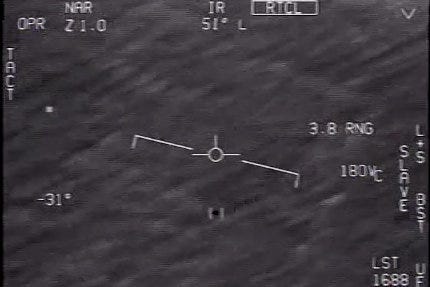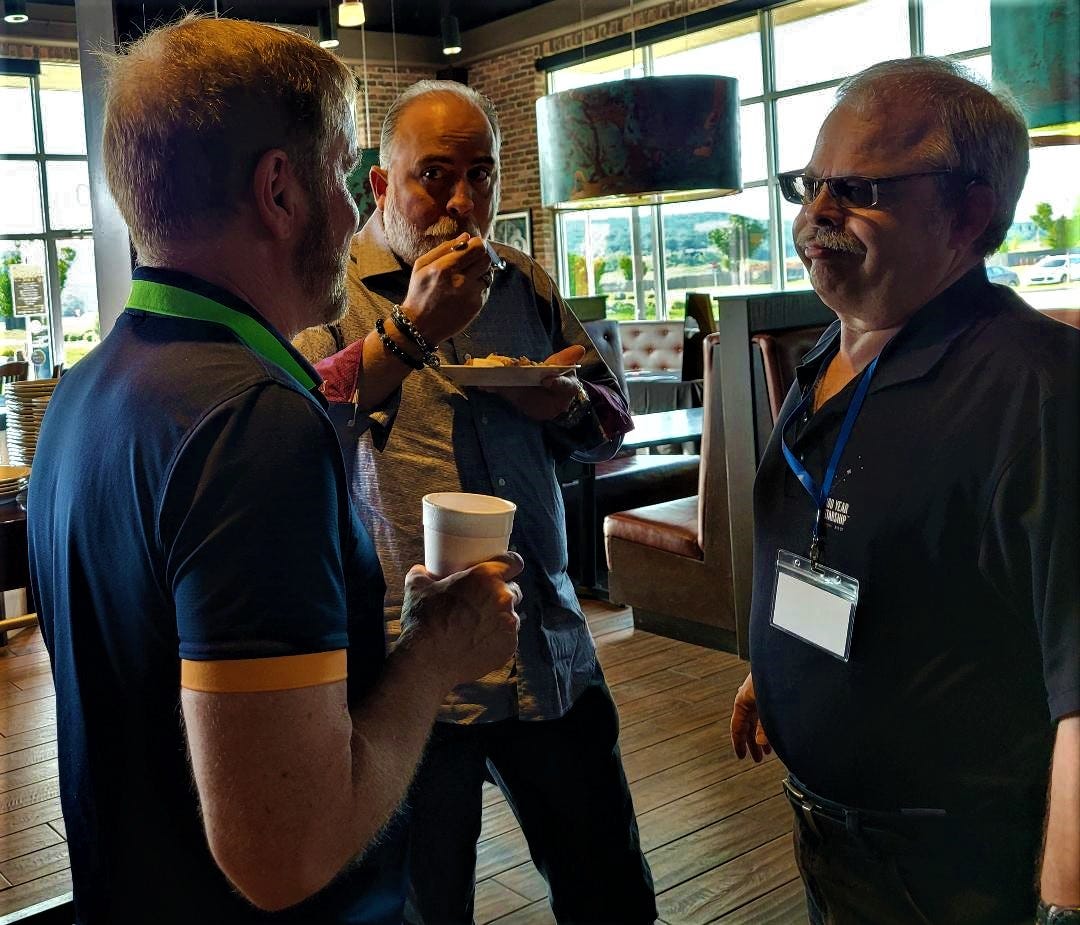Why was an “Urgent: Safety of Flight Issue” email containing the “GoFast” UFO video deleted without explanation from naval commanders’ computers in 2015?
Retired Rear Admiral Tim Gallaudet, former deputy administrator of the National Oceanic and Atmospheric Administration, doesn’t want to get sidetracked by the so-called Wilson Memo controversy. He never met fellow Navy flag officer and former Defense Intelligence Agency director Thomas Wilson, and he has no personal knowledge of the events described in the Memo.
There is, however, an aspect of those papers, fabricated or not, that sounds authentic. And that’s the alleged outrage Wilson unleashes as he recounts, in 2002, being denied access to a classified Defense Department UFO research program. Wilson has dismissed the Memo as fiction, but Gallaudet’s takeaway has nothing to do with the veracity of the document itself.
“I’m sure it’s legitimate in terms of being an example of something I’ve seen first hand,” says Gallaudet, “and that is, a senior officer who wants to get read into a compartmented program, and the career bureaucrats who own the program tell them they don’t need to know.
“I understand the need for secrecy, but I have a problem when they do that to leadership. I was in a leadership position, and when you cut out leadership that’s accountable to the executive branch and the Congress for information, I don’t think that’s lawful. Congress now knows they’ve been shut out for a long time, and that’s why they’re calling for legislation. And I think that’s great.”
Spurred by the dramatic bipartisan UFO debate on Capitol Hill, Gallaudet may be the highest ranking former military officer yet to challenge the Pentagon’s crumbling obstructionism and push for a full accounting of the mystery. And on July 29, he’ll be the keynote speaker at the Scientific Coalition for UAP Studies’ annual “Anomalous Aerospace Phenomena Conference,” the most consequential public gathering of researchers and investigators in the United States.
Gallaudet will address virtual audiences amid a blur of rapidly unfolding events. Last week, Senate Majority Leader Chuck Schumer unveiled a wildly ambitious, 64-page, $20 million amendment to support the “Unidentified Anomalous Phenomena Disclosure Act of 2023.” If ratified, it will give feds the power to assert eminent domain “over any and all recovered technologies of unknown origin and biological evidence of non-human intelligence that may be controlled by private persons or entities in the interests of the public good.”
Still fuming over military command for impeding access to UFO eyewitnesses at Eglin Air Force Base in February, Tennessee Republican Tim Burchett is snapping the House Oversight Committee into action. On Wednesday, they intend to hear what Intelligence Community whistleblower David Grusch has to say, along with two newsmaking Navy pilots. Also, NASA’s blueprint on how to proceed with UFO research going forward is due any day now.
Keep an eye out for VIP guests
Given the snowballing public interest in America’s secret UFO projects (in spite of the legacy media’s continued apathy), Gallaudet batted away a suggestion that things are moving too quickly. “I think the real danger is if we don’t (move quickly),” he said. “Whatever they are, they’re here. And the more we can learn, the better.”
Few are savoring the possibilities like SCU co-founder Rich Hoffman. The non-profit’s headline speakers since 2019 read like a Who’s Who of transparency activists: Luis Elizondo, the former counterintelligence agent who worked with the New York Times to bust the secret-program story in 2017; physicist Hal Puthoff, who produced a paper titled “Advanced Space Propulsion Based on Vacuum (space-time metric) Engineering” for the Defense Intelligence Agency’s UFO project; and retired F-18 Navy pilot Ryan Graves, who began speaking up following his squadron’s near-miss encounters over the Atlantic in 2015. Graves will be joining the Oversight Committee’s witness panel next week in Washington.
But maybe the best stories belong to the quasi-anonymous listeners in SCU’s audience.
Hoffman was gobsmacked in June when Grusch went public about recovered craft and secret research programs. In a televised interview with Ross Coulthart and NewsNation, the story got even darker when the 36-year-old intelligence officer alluded to UFO pilot cadavers, veiled behind what Grusch reported are threats, bodily harm and maybe even death.
At home in Huntsville, Alabama, site of the 2022 SCU meeting, Hoffman couldn’t help but remember Grusch’s name. He’d made out individual name tags for last year’s guests. “There were tables reserved for some pretty high-ranking people,” including a small posse from the National Geospatial-intelligence Agency. “So David, his boss, and his boss’s boss from the NGA were all there.”
Twelve months later . . .
“Well, first, you do things like go, holy shit, you know?” Hoffman chuckles in disbelief. “And then you get past that, and you go, wow, I didn’t even have a chance to talk the guy because I was so busy at the conference. (John) Alexander [the retired Army colonel whose remote viewing project endured a lame Hollywood dramedy, “The Men Who Stare at Goats”] sent me a photo and said, Did you see this? It’s a photo of (Grusch) and (former UAP Task Force director) Jay Stratton and (UAP Task Force lead scientist) Travis Taylor and they’re all sitting together, having a conversation. I would’ve loved to have been in on that.”
Three amigos sharing ideas at the 2022 SCU conference: Stanford immunologist/experiencer Garry Nolan, former UAP Task Force director Jay Stratton, and physicist Eric Davis, who refuses to address the Wilson Memo he allegedly wrote.
Unlike 2022, SCU will go virtual this weekend because an alternate venue fell through. Sponsoring an in-house conference is a world-class time suck, and “my wife would like me to retire,” Hoffman says.
Casting an even broader net this year, SCU could easily surpass the 250 local and remote attendees who typically tune in. Presenters are from Sweden, Norway, Germany, Israel, New Zealand, Canada, France, South Africa and Australia. In hopes of engaging younger generations, SCU has also invited three university students to describe their ongoing research in academia. Hoffman is also calling for more women to join the discussion. He hoped to schedule Anamaria Berea, a member of NASA’s UAP Study Team, to talk about the space agency’s upcoming ideas for confronting The Great Taboo. Berea is an astronomer specializing SETI’s exoplanetary survey for technosignatures; however, given the imminent but uncertain release date of the space agency’s recommendations, she took a pass.
International initiatives will get a critical airing at the two-day conference. Behind a campaign called Project Titan, the tiny nation of San Marino is lobbying for the United Nations to establish a permanent UAP office to promote global discourse. France has maintained an official government research program for more than 40 years, and two members of its SIGMA 2 commission will share the results of its methodologies, along with updates on its data-swapping partnership with Chile. Erling Strand, who’s been wiring Norway’s Hessdalen valley with sensors since 1983, will propose a hypothesis for the century-old Scandinavian UAP puzzle.
But here in the U.S., things are happening so quickly, Hoffman struggles to process the implications. Gaming out the consequences of Schumer’s UAP Disclosure amendment at this stage seems impossible. “You’ve gotta ask – is this really gonna draw information out? Or will they go deeper with their stuff and hide it better?” And some of David Grusch’s allegations sound like Agatha Christie meets Philip K. Dick. “I’ve heard of people getting injured by objects like Colares (Brazil),” says Hoffman. “But humans killed? I’m hard pressed to think of any cases I know of.”
But maybe the most urgent question is raised by the very name of the Senate-envisioned Controlled Disclosure Campaign Plan. “What do those words even mean? Tell the general public? Disclosure to the government? Disclose to who?” Hoffman wonders. “We need to get behind what our narrative should be, how the news of a crashed craft would be delivered – by who, when and where?”
Career oceanographer Tim Gallaudet hopes to be in thick of it. A research affiliate with Harvard’s Galileo project, advisory board member to Ryan Graves’ “Americans for Safe Aerospace,” and former Naval Meteorology and Oceanography Command boss at NASA’s Stennis Space Center in Mississippi, the USN’s erstwhile top weatherman is flaunting his credentials to lure more high-placed witnesses and advocates out of the closet. Here’s why:
The sounds of silence
In 2015, when Navy pilots were encountering heightened and dangerous UAP activity off the eastern seaboard, Gallaudet’s sailors were aboard the USS Roosevelt. He and maybe 20 subordinate commanders received a SIPRNet email from their operations officer at U.S. Fleet Forces Command in Norfolk, titled “Urgent: Safety of Flight Issue.” Gallaudet was at his station in Mississippi when the brief text arrived, along with a video attachment of the UFO known today as GoFast.
“The boss asked if anyone knew what these objects were that were causing multiple midair near-collisions, because if it keeps on happening, they were going to have to cancel the exercises,” Gallaudet remembers. “He obviously thought one of us might be doing experiments with these things, drones, whatever.”
Gallaudet was in for a surprise the next day. The email had been deleted from his and his deputy’s computer without explanation — no precedent for that. Stranger still, nobody uttered word one about what had just the day before been declared “Urgent.” Nobody. Ever. Like it never happened.
“Which was really ridiculous, because I was the chief meteorologist for the Navy and my job was to ensure safety of flight. Not having a discussion about the safety issue was a surprise to me.”
A few years later, he watched as former pilots, one by one, like Graves, David Fravor (who will also be at Wednesday’s Oversight Committee hearing), Alex Dietrich, Jim Sleight, and Chad Underwood stepped forward with news of high-speed close encounters.
“And the relatively junior people, people like Sean Cahill, Kevin Day, they’re all coming out and showing a lot of courage” Gallaudet remembers. “And I figured, as a flag officer, I ought to step up, too. I think it’s an important issue, and more voices like mine will be helpful to get this disclosure out for the benefit of the country.”
Gallaudet’s dream assignment: Hunting for unidentified submerged objects, USOs. Forget badgering the Navy for super-secret data at this point — multidisciplinary oceanographers, he says, may have already acquired a ton of non-classified USO evidence.
“There are plenty of large networks of ocean observing systems out there for oceanography and marine biology. My old agency, NOAA, they have these capabilities and underwater drones monitoring the oceans right now, a lot of universities have capabilities. Whether it be acoustic or in situ sampling, there’s a lot of wide instrumentation out there.
“My thinking is, I’d like to have the Naval Studies Board do a survey of all the universities that have ocean datasets and look for anomalous phenomena. Because right now, with the ocean being so opaque, we haven’t sampled very much of it, not as much as the atmosphere, and anything that appears anomalous would be regarded as noise. If we could look at that ‘noise’ and find patterns, that would give us some direction for where to place sensors for future studies.”
How much would it take to review an archived-data survey? Gallaudet figures $1-2 million over one to two years, depending on staffing, resources, etc. In other words, roughly the total price of the Sidewinder missiles that took out three UFOs over North America in February.
Unfortunately, the Pentagon continues to withhold that shootdown footage from those of us who paid for it.






good work, thank you!
“‘Congress now knows they’ve been shut out for a long time, and that’s why they’re calling for legislation. And I think that’s great.’”
Now, Congress must show who’s the boss.